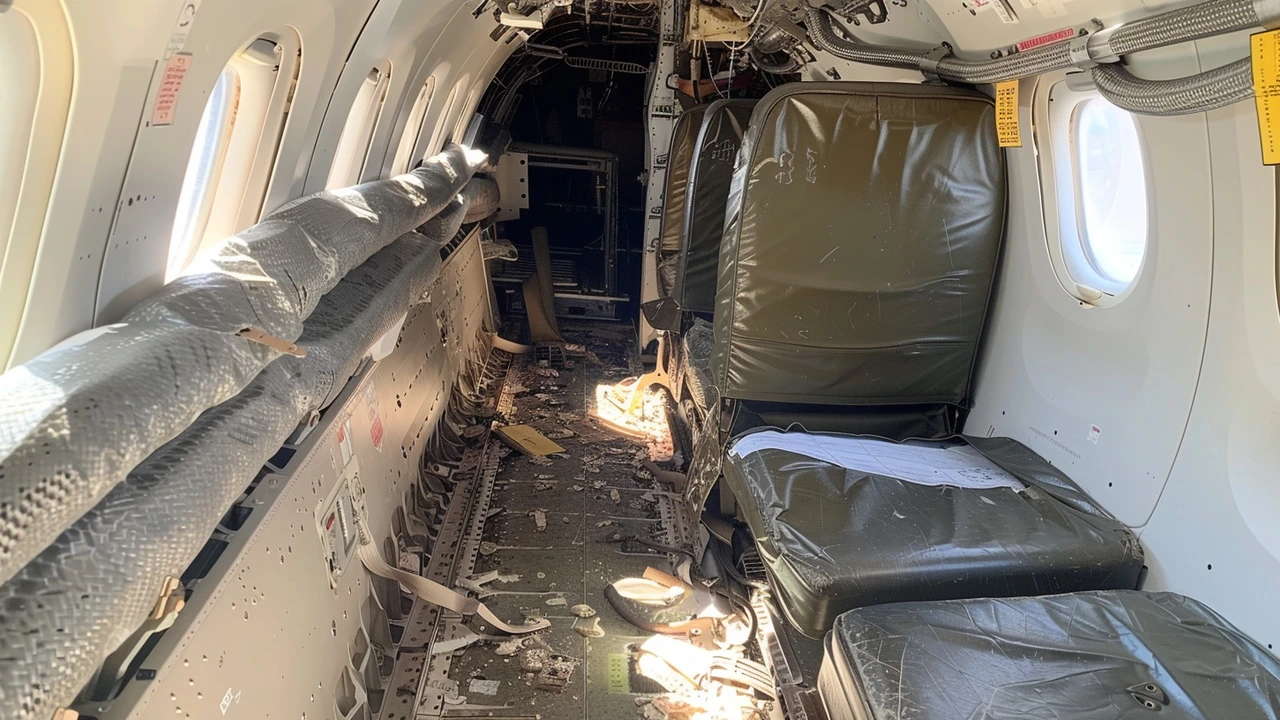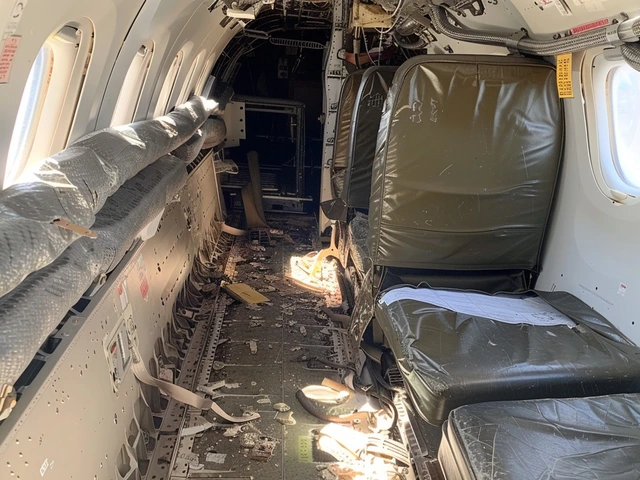Fatal Turbulence Hits Singapore Airlines Flight
A Singapore Airlines Boeing 777-300ER en route from London to Singapore encountered severe turbulence, resulting in an emergency landing in Bangkok. This unexpected event tragically claimed the life of one passenger and left over 30 others injured. The distressing incident has drawn significant attention to the safety of aviation travel and the unpredictable nature of in-flight experiences.
The Unfolding of the Incident
On the fated day, flight SQ308 carrying 211 passengers and 18 crew members set off from Heathrow Airport with a routine schedule, unaware of the adversity that lay ahead. Mid-flight, while traversing high above the South Asian skies, the aircraft was suddenly gripped by violent turbulence. Passengers were jolted awake, and the cabin atmosphere turned chaotic as belongings were tossed around, and people were thrown from their seats. Descriptions from those on board recount a scene of panic and fear, as the sudden and severe turbulence struck without warning.
Immediate Response and Emergency Landing
Captain Tan Wei Teck, who was at the helm, quickly assessed the dire situation and decided to divert the plane for an emergency landing at the nearest possible airport. Bangkok’s Suvarnabhumi Airport was swiftly contacted and prepared for the urgent landing. Air traffic control cleared a path, and emergency services were positioned to receive the incoming flight. The plane successfully landed in Bangkok, where medical teams were ready to attend to the wounded. Sadly, one passenger succumbed to injuries sustained during the turbulence, despite the prompt emergency response.
Aftermath and Responses
In the wake of the incident, Singapore Airlines has expressed profound sorrow, extending condolences to the family of the deceased passenger. The airline confirmed that 31 individuals were admitted to local hospitals, with a range of injuries, including fractures, bruises, and shock. The company assured that all affected passengers and crew would receive the necessary support, be it medical aid or psychological counselling.
Reactions and Broader Implications
The incident has sparked widespread concern among aviation experts and the general public alike. Experts have emphasized that turbulence, while a known hazard in aviation, can often be unpredictable and severe. Passengers are always advised to keep their seatbelts fastened when seated, underscoring the unpredictable nature of such mid-air phenomena. Yet, the severity of this turbulence has raised questions about the measures taken by airlines to assure passenger safety, even if such events are statistically rare.
The Nature of Turbulence
Turbulence is caused by various atmospheric conditions, including jet streams, thunderstorms, and air pressure differences. Pilots routinely navigate these disturbances, relying on instruments and atmospheric data to avoid the most dangerous areas. However, despite technological advancements, some turbulence strikes with little to no warning, making it nearly impossible to prevent all such incidents. This incident on the London-Singapore route serves as a stark reminder of the elements at play in aviation and the importance of preparedness and vigilance.
Support and Safety Measures
Singapore Airlines has vowed to uphold stringent safety protocols and reinforce training for crew members to manage such emergencies. The airline, known for its commitment to safety and service, reassured travelers of its dedication to continuous improvements in safety measures. The company’s crisis management team has been actively working with Bangkok authorities to provide support and coordinate the repatriation of those affected.
Personal Accounts and Testimonies
Several passengers have spoken out about their terrifying experience. Sandra Lee, a business traveler, recounted how she was thrown against her seatbelt and watched in horror as other passengers were flung into the air. Parents tried desperately to hold onto their children, and the crew worked tirelessly to calm and assist those in distress. Another passenger, Jamal Singh, shared his profound relief upon landing and the overwhelming gratitude he felt for the quick-thinking crew and rescue workers.
Conclusion
This tragic incident serves as a sobering reminder of the unpredictable nature of air travel and the vital importance of safety protocols. As the aviation community reflects on this event, passengers and airlines alike will continue to prioritize safety and preparedness in every journey. Singapore Airlines, along with the global aviation industry, extends its deepest sympathy to the victims and their families, committing to ongoing efforts to safeguard the skies for all who travel.
As investigations continue, the focus remains on learning from this incident to prevent future occurrences, ensuring that every flight, while an act of traversing the heavens, remains firmly grounded in safety and care.



Comments
We need to remember turbulence is a natural phenomenon, but airlines must double‑down on predictive analytics and real‑time data sharing. Passengers shouldn't be left to chance; seat‑belt enforcement must become routine, not optional. I expect Singapore Airlines to push for tighter protocols and better crew training.
Your concerns are duly noted, and I would like to commend the airline for its swift response. It is imperative that we continue to uphold the highest standards of safety. Let us collectively support the ongoing investigations.
The sky may seem calm, but the atmosphere is a chaotic tapestry of forces we are still learning to map. When turbulence hits without warning, it reminds us of humanity's modest place among the clouds. I admire the crew's composure under pressure; they turned a terrifying moment into a coordinated rescue. This event should spark a deeper conversation about how we integrate advanced meteorological modeling into flight planning. Until we master the heavens, humility and vigilance remain our best allies.
Wow, what a nightmare! 😱 But the crew really stepped up, and that's something to appreciate. 🙏 Stay safe, folks, always keep that belt fastened.
The incident underscores a cascade of systemic vulnerabilities that merit rigorous scrutiny. Firstly, the turbulence prediction algorithms currently deployed rely on coarse-grained atmospheric models that may miss micro‑scale convective cells, thereby underestimating the probability of severe shear zones. Secondly, the communication protocols between meteorological offices and flight crews often suffer from latency, limiting the real‑time dissemination of critical updates. Thirdly, the cabin safety briefings, while mandatory, frequently omit explicit instructions on brace positions for unexpected vertical accelerations, which could mitigate injury severity. Moreover, the structural integrity of seat anchorage points, though certified, might benefit from reinforcement to withstand the forces observed in such episodes. In addition, the ergonomic design of overhead compartments should be revisited to prevent hazardous projectile trajectories during violent jolts. From an operational perspective, the decision matrix that triggers an emergency diversion must incorporate a weighted risk assessment that balances passenger wellbeing against logistical constraints. The post‑incident medical triage also reveals a need for standardized protocols across jurisdictions to expedite care for fractured limbs and contusions. Psychologically, the trauma inflicted by sudden turbulence can precipitate acute stress reactions, necessitating systematic debriefing sessions and longitudinal mental health monitoring for both passengers and crew. Financially, airlines are compelled to allocate resources for compensation, legal counsel, and potential regulatory fines, thereby influencing their cost‑benefit analyses regarding safety investments. Lastly, the regulatory bodies overseeing aviation safety should consider mandating enhanced turbulence detection sensors, akin to those used in marine navigation, to provide pilots with actionable data well before encountering hazardous air currents. Collectively, these multilayered considerations form a comprehensive framework aimed at bolstering aviation safety and restoring public confidence.
It is our moral duty to demand uncompromising safety standards from all carriers.
I was reading the reports and felt a deep empathy for the injured passengers. 😔 It’s heartbreaking to think about the pain they endured, but I’m hopeful that the airline’s support will make a real difference. Please, if anyone needs resources or talking, reach out.
yeah the crew really did a solid job keeping everyone calm during the chaos they were awesome
Indeed, the event serves as a stark reminder, of how even the most advanced aircraft, can still be vulnerable, to the whims of nature; consequently, airlines, must prioritize, continuous training, and invest, in cutting‑edge turbulence detection technologies, to safeguard, every passenger, on board.
Safety first, always.
While we commend the quick response, it's evident that national standards must be enforced rigorously; our aviation policy should mandate zero‑tolerance for any lapse, leveraging proprietary risk‑assessment algorithms to preempt such catastrophes.
Man, that was scary! Good thing the crew handled it well. Stay buckled next time!
Life throws us turbulence, both in the air and on the ground, but with a calm mind and a supportive community we can navigate any storm.